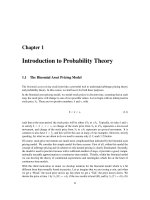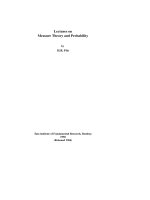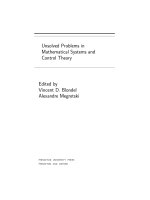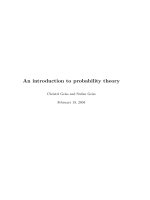Statistics in geophysics introduction and probability theory
Bạn đang xem bản rút gọn của tài liệu. Xem và tải ngay bản đầy đủ của tài liệu tại đây (1.64 MB, 32 trang )
Introduction
Probability Theory
Statistics in Geophysics: Introduction and
Probability Theory
Steffen Unkel
Department of Statistics
Ludwig-Maximilians-University Munich, Germany
Winter Term 2013/14
1/32
Introduction
Probability Theory
What is Statistics?
“Statistics is the discipline concerned with the study of variability,
with the study of uncertainty, and with the study of decision-making
in the face of uncertainty.” (Lindsay, et al. (2004): A report on the
future of Statistics, Statistical Science, Vol. 19, p. 388)
Statistics is commonly divided into two broad areas:
Descriptive Statistics
Inferential Statistics
The descriptive side of statistics pertains to the organization and
summarization of data.
Inferential statistics consists of methods used to draw conclusions
regarding underlying processes that generate the data (population),
by examining only a part of the whole (sample).
Winter Term 2013/14
2/32
Introduction
Probability Theory
Statistics in Geophysical Sciences
Geophysics can be subdivided by the part of the Earth studied.
One natural division is into atmospheric science, ocean science
and solid-Earth geophysics, with the solid Earth further
divided into the crust, mantle and core.
“As mainstream physics has moved to study smaller objects and
more distant ones, geophysics has moved closer to geology, and its
mathematical content has become generally more dilute, with
important singularities. The subject is driven largely by observation
and data analysis, rather than theory, and probabilistic modeling
and statistics are key to its progress.” (see Stark, P. B. (1996))
Winter Term 2013/14
3/32
Introduction
Probability Theory
Statistics in Geophysical Sciences: Example
Kraft, T., Wassermann, J., Schmedes, E., Igel, H. (2006):
Meteorological triggering of earthquake swarms at Mt.
Hochstaufen, SE-Germany, Tectonophysics, Vol. 424 No. 3-4, pp.
245-258.
/>kraftetal_tecto_2006.pdf
Winter Term 2013/14
4/32
Introduction
Probability Theory
Example 2: The Hochstaufen earthquake swarms
Statistics in Geophysical Sciences: Example
Mount Hochstaufen earthquakes
5 / 42
Winter Term 2013/14
5/32
Research question
Introduction
Probability Theory
Statistics in Geophysical Sciences: Example
40 80
0
Rainfall Amount
Is there a relationship between rainfall and earthquakes ?
0
500
1000
1500
2000
Days since January 1st, 2002
Winter Term 2013/14
6/32
6 / 42
Introduction
Probability Theory
Number
of inearthquakes
Statistics
Geophysical Sciences: Example
Number
of Quakes in each of the Categories of Depth
●
●
●
●
5
4
3
2
1
●
●●
●
●
●
●●● ●
●
●
●
● ●
●●●●
●
●
●
●
●
●
●●
●● ●●
●
●
●
●
●
●
●●
●
●●●
●
● ●
●
●
●
●
●
●●●
●
●●
●
●
●
●●
●●
●
●
●
●●
●
●
●
●
●
●
●
●
●
●●
●●
●
●
●●
●
●
●
●
●●
●●
●
●●●
●●●
●
●
●
●● ●
●●
● ●●
●
●
●
●
●
●
●
●
●
●
●
●
●
●
●
●
●
●
●
●
●
●
●
●
●
●
●
●
●
●
●
●
●
●
●
●
●
●
●
●
●
●
●
●
●
●
●
●
●
●
●
●
●
●
●
●
●
●
●
●
●
●
●
●
●
●
●
●
●
●
●
●
●
●
●
●
●
●
●
●
●
●
●
●
●
●
●
●
●
●
●
●
●
●
●
●
●
●
●
●
●
●
●
●
●
●
●
●
●
●
●
●
●
●
●
●
●
●
●
●
●
●
●
●
●
●
●
●
●
●
●
●
●
●
●
●
●
●
●
●
●
●
●
●
●
●
●
●
●
●
●
●
●
●
●
●
●
●
●
●
●
●
●
●
●
●
●
●
●
●
●
●
●
●
●
●
●
●
●
●
●
●
●
●
●
●
●
●
●
●
●
●
●
●
●
●
●
●
●
●
●
●
●
●
●
●
●
●
●
●
●
●
●
●
●
●
●
●
●
●
●
●
●
●
●
●
●
●
●
●
●
●
●
●
●
●
●
●
●
●
●
●
●
●
●
●
●
●
●
●
●
●
●
●
●
●
●
●
●
●
●
●
●
●
●
●
●
●
●
●
●
●
●
●
●
●
●
●
●
●
●
●
●
●
●
●
●
●
●
●
●
●
●
●
●
●
●
●
●
●
●
●
●
●
●
●
●
●
●
●
●
●
●
●
●
●
●
●
●
●
●
●
●
●
●
●
●
●
●
●
●
●
●
●
●
●
●
●
●
●
●
●
●
●
●
●
●
●
●
●
●
●
●
●
●
●
●
●
●
●
●
●
●
●
●
●
●
●
●
●
●
●
●
●
●
●
●
●
●
●
●
●
●
●
●
●
●
●
●
●
●
●
●
●
●
●
●
●
●
●
●
●
●
●
●
●
●
●
●
●
●
●
●
●
●
●
●
●
●
●
●
●
●
●
●
●
●
●
●
●
●
●
●
●
●
●
●
●
●
●
●
●
●
●
●
●
●
●
●
●
●
●
●
●
●
●
●
●
●
●
●
●
●
●
●
●
●
●
●
●
●
●
●
●
●
●
●
●
●
●
●
●
●
●
●
●
●
●
●
●
●
●
●
●
●
●
●
●
●
●
●
●
●
●
●
●
●
●
●
●
●
●
●
●
●
●
●
4
●
●
● ●
Number of Quakes
●
● ●●
●●
●
●
●
● ●
●●
●
●
●●
●●
●●
● ●●
●●
●
●
●●
●
●
●
●
●
●
●
●
●
●
● ●●●
●
●
●
●
●
●
●
●●
●
●
●
●
●●
●●●
●
●●
●●
●
●
●●●
●
●
●
●
●
●●
4
3
2
1
●
●
●
●
●
●
●
●
●
●
●
●
●
●
●
●
●
●
●
●
●
●
●
●
●
●
●
●
●
●
●
●
●
●
●
●
●
●
●
●
●
●
●
●
●
●
●
●
●
●
●
●
●
●
●
●●
●
●
●
●
●
●
●
●
●
●
●
●
●
●
●
●
●
●
●
●
●
●
●
●
●
●
●
●
●
●
●
●
●
●
●
●
●
●
●
●
●
●
●
●
●
●
●
●
●
●
●
●
●
●
●
●
●
●
●
●
●
●
●
●
●
●
●
●
●
●
●
●
●
●
●
●
●
●
●
●
●
●
●
●
●
●
●
●
●
●
●
●
●
●
●
●
●
●
●
●
●
●
●
●
●
●
●
●
●
●
●
●
●
●
●
●
●
●
●
●
●
●
●
●
●
●
●
●
●
●
●
●
●
●
●
●
●
●
●
●
●
●
●
●
●
●
●
●
●
●
●
●
●
●
●
●
●
●
●
●
●
●
●
●
●
●
●
●
●
●
●
●
●
●
●
●
●
●
●
●
●
●
●
●
●
●
●
●
●
●
●
●
●
●
●
●
●
●
●
●
●
●
●
●
●
●
●
●
●
●
●
●
●
●
●
●
●
●
●
●
●
●
●
●
●
●
●
●
●
●
●
●
●
●
●
●
●
●
●
●
●
●
●
●
●
●
●
●
●
●
●
●
●
●
●
●
●
●
●
●
●
●
●
●
●
●
●
●
●
●
●
●
●
●
●
●
●
●
●
●
●
●
●
●
●
●
●
●
●
●
●
●
●
●
●
●
●
●
●
●
●
●
●
●
●
●
●
●
●
●
●
●
●
●
●
●
●
●
●
●
●
●
●
●
●
●
●
●
●
●
●
●
●
●
●
●
●
●
●
●
●
●
●
●
●
●
●
●
●
●
●
●
●
●
●
●
●
●
●
●
●
●
●
●
●
●
●
●
●
●
●
●
●
●
●
●
●
●
●
●
●
●
●
●
●
●
●
●
●
●
●
●
●
●
●
●
●
●
●
●
●
●
●
●
●
●
●
●
●
●
●
●
●
●
●
●
●
●
●
●
●
●
●
●
●
●
●
●
●
●
●
●
●
●
●
●
●
●
●
●
●
●
●
●
●
●
●
●
●
●
●
●
●
●
●
●
●
●
●
●
●
●
3
●
4
3
2
1
●●
●●
●
●●
●
●
●
●
●●
●●
●
●●
●●
●
●● ●
●●
●
●●
●● ●●
●
●
●
●
●
●
●
●
●
●
●
●
●
●●
●
●
●
●
●●
●●
●
●●
●
●
●
●
●
●
●
●
●●
●
●
● ●●
●
●●
●
●
●●●● ●
● ●
●
●
●
●
●
●
●
●
●
●
●
●
●
●
●
●
●
●
●
●
●
●
●
●
●
●
●
●
●
●
●
●
●
●
●
●
●
●
●
●
●
●
●
●
●
●
●
●
●
●
●
●
●
●
●
●●
●
●
●
●
●
●
●
●
●
●
●
●
●
●
●
●
●
●
●
●
●
●
●
●
●
●
●
●
●
●
●
●
●
●
●
●
●
●
●
●
●
●
●
●
●
●
●
●
●
●
●
●
●
●
●
●
●
●
●
●
●
●
●
●
●
●
●
●
●
●
●
●
●
●
●
●
●
●
●
●
●
●
●
●
●
●
●
●
●
●
●
●
●
●
●
●
●
●
●
●
●
●
●
●
●
●
●
●
●
●
●
●
●
●
●
●
●
●
●
●
●
●
●
●
●
●
●
●
●
●
●
●
●
●
●
●
●
●
●
●
●
●
●
●
●
●
●
●
●
●
●
●
●
●
●
●
●
●
●
●
●
●
●
●
●
●
●
●
●
●
●
●
●
●
●
●
●
●
●
●
●
●
●
●
●
●
●
●
●
●
●
●
●
●
●
●
●
●
●
●
●
●
●
●
●
●
●
●
●
●
●
●
●
●
●
●
●
●
●
●
●
●
●
●
●
●
●
●
●
●
●
●
●
●
●
●
●
●
●
●
●
●
●
●
●
●
●
●
●
●
●
●
●
●
●
●
●
●
●
●
●
●
●
●
●
●
●
●
●
●
●
●
●
●
●
●
●
●
●
●
●
●
●
●
●
●
●
●
●
●
●
●
●
●
●
●
●
●
●
●
●
●
●
●
●
●
●
●
●
●
●
●
●
●
●
●
●
●
●
●
●
●
●
●
●
●
●
●
●
●
●
●
●
●
●
●
●
●
●
●
●
●
●
●
●
●
●
●
●
●
●
●
●
●
●
●
●
●
●
●
●
●
●
●
●
●
●
●
●
●
●
●
●
●
●
●
●
●
●
●
●
●
●
●
●
●
●
●
●
●
●
●
●
●
●
●
●
●
●
●
●
●
●
●
●
●
●
●
●
●
●
●
●
●
●
●
●
●
●
●
●
●
●
●
●
●
●
●
●
●
●
●
●
●
●
●
●
●
●
●
●
●
●
●
●
●
●
●
●
●
●
●
●
●
●
●
●
●
●
●
●
●
2
●●
●
●
●
●● ●●
●
●
●
●
●
●●
●
●
●
●●● ●
●
●
●● ●●
●
●
●●
●●● ●
●●
●
●
●
●
●
●
●
●
●
●●
●●
●
●
●●
●●
●
●
● ●●
●
●●
●● ● ●
● ●
●
● ●
●
●●●
●
●●
●●
●●
●●●
●
●●
●
●
●
●
●
●
●
●
●
●
●
●
●
●
●
●
●
●
●
●
●
●
●
●●
●
●
●
●
●
●
●
●
●
●
●
●
●
●
●
●
●
●
●
●
●
●
●
●
●
●
●
●
●
●
●
●
●
●
●
●
●
●
●
●
●
●
●
●
●
●
●
●
●
●
●
●
●
●
●
●
●
●
●
●
●
●
●
●
●
●
●
●
●
●
●
●
●
●
●
●
●
●
●
●
●
●
●
●
●
●
●
●
●
●
●
●
●
●
●
●
●
●
●
●
●
●
●
●
●
●
●
●
●
●
●
●
●
●
●
●
●
●
●
●
●
●
●
●
●
●
●
●
●
●
●
●
●
●
●
●
●
●
●
●
●
●
●
●
●
●
●
●
●
●
●
●
●
●
●
●
●
●
●
●
●
●
●
●
●
●
●
●
●
●
●
●
●
●
●
●
●
●
●
●
●
●
●
●
●
●
●
●
●
●
●
●
●
●
●
●
●
●
●
●
●
●
●
●
●
●
●
●
●
●
●
●
●
●
●
●
●
●
●
●
●
●
●
●
●
●
●
●
●
●
●
●
●
●
●
●
●
●
●
●
●
●
●
●
●
●
●
●
●
●
●
●
●
●
●
●
●
●
●
●
●
●
●
●
●
●
●
●
●
●
●
●
●
●
●
●
●
●
●
●
●
●
●
●
●
●
●
●
●
●
●
●
●
●
●
●
●
●
●
●
●
●
●
●
●
●
●
●
●
●
●
●
●
●
●
●
●
●
●
●
●
●
●
●
●
●
●
●
●
●
●
●
●
●
●
●
●
●
●
●
●
●
●
●
●
●
●
●
●
●
●
●
●
●
●
●
●
●
●
●
●
●
●
●
●
●
●
●
●
●
●
●
●
●
●
●
●
●
●
●
●
●
●
●
●
●
●
●
●
●
●
●
●
●
●
●
●
●
●
●
●
●
●
●
●
●
●
●
●
●
●
●
●
●
●
●
●
●
●
●
●
●
●
●
●
●
●
●
●
●
●
●
●
●
●
●
●
●
●
●
●
●
●
●
●
●
●
●
●
●
●
●
●
●
●
●
●
●
●
●
●
●
●
●
●
●
●
●
●
●
●
●
●
●
●
●
●
●
●
●
●
●
●
●
●
●
●
●
●
●
●
●
●
●
●
●
1
●
4
3
2
1
●
●●
●●
●
●
●
●
●
●
●●
●
●
●
●●
●
● ●●
●
●
●
●
●
●
●●
●
●
●
●
●
●
●
●●
●
●
●
●●
●
●
●
●
●
●
●
●
●
●
●
●
●
●
●
●
●
●
●
●
●
●
●
●
●
●
●
●
●
●
●
●
●
●
●
●
●
●
●
●
●
●
●
●
●
●
●
●
●
●
●
●
●
●
●
●
●
●
●
●
●
●
●
●
●
●
●
●
●
●
●
●
●
●
●
●
●
●
●
●
●
●
●
●
●
●
●
●
●
●
●
●
●
●
●
●
●
●
●
●
●
●
●
●
●
●
●
●
●
●
●
●
●
●
●
●
●
●
●
●
●
●
●
●
●
●
●
●
●
●
●
●
●
●
●
●
●
●
●
●
●
●
●
●
●
●
●
●
●
●
●
●
●
●
●
●
●
●
●
●
●
●
●
●
●
●
●
●
●
●
●
●
●
●
●
●
●
●
●
●
●
●
●
●
●
●
●
●
●
●
●
●
●
●
●
●
●
●
●
●
●
●
●
●
●
●
●
●
●
●
●
●
●
●
●
●
●
●
●
●
●
●
●
●
●
●
●
●
●
●
●
●
●
●
●
●
●
●
●
●
●
●
●
●
●
●
●
●
●
●
●
●
●
●
●
●
●
●
●
●
●
●
●
●
●
●
●
●
●
●
●
●
●
●
●
●
●
●
●
●
●
●
●
●
●
●
●
●
●
●
●
●
●
●
●
●
●
●
●
●
●
●
●
●
●
●
●
●
●
●
●
●
●
●
●
●
●
●
●
●
●
●
●
●
●
●
●
●
●
●
●
●
●
●
●
●
●
●
●
●
●
●
●
●
●
●
●
●
●
●
●
●
●
●
●
●
●
●
●
●
●
●
●
●
●
●
●
●
●
●
●
●
●
●
●
●
●
●
●
●
●
●
●
●
●
●
●
●
●
●
●
●
●
●
●
●
●
●
●
●
●
●
●
●
●
●
●
●
●
●
●
●
●
●
●
●
●
●
●
●
●
●
●
●
●
●
●
●
●
●
●
●
●
●
●
●
●
●
●
●
●
●
●
●
●
●
●
●
●
●
●
●
●
●
●
●
●
●
●
●
●
●
●
●
●
●
●
●
●
●
●
●
●
●
●
●
●
●
●
●
●
●
●
●
●
●
●
●
●
●
●
●
●
●
●
●
●
●
●
●
●
●
●
●
●
●
●
●
●
●
●
●
●
●
●
●
●
●
●
●
●
●
●
●
0
500
1000
1500
Days since January 1st, 2002
Winter Term 2013/14
7/32
2000
4
3
2
1
Introduction
Probability Theory
Course outline
Probability Theory
Descriptive Statistics
Inferential Statistics
Linear Regression
Generalized Linear Regression
Multivariate Methods
Winter Term 2013/14
8/32
Introduction
Probability Theory
Set theory
The meaning of probability
Some properties of the probability function
Uncertainty in Geophysics
Our uncertainty about almost any system is of different
degrees in different instances.
For example, you cannot be completely certain
whether or not rain will occur at hour home tomorrow, or
whether the average temperature next month will be greater or
less than the average temperature this month.
We are faced with the problem of expressing degrees of
uncertainty.
It is preferable to express uncertainty quantitatively. This is
done using numbers called probabilities.
Winter Term 2013/14
9/32
Introduction
Probability Theory
Set theory
The meaning of probability
Some properties of the probability function
Sample space
The set, Ω, of all possible outcomes of a particular experiment
is called the sample space for the experiment.
If the experiment consists of tossing a coin with outcomes
head (H) or tail (T), then
Ω = {H, T} .
Consider an experiment where the observation is reaction time
to a certain stimulus. Here,
Ω = (0, ∞) .
Sample spaces can be either countable or uncountable.
Winter Term 2013/14
10/32
Introduction
Probability Theory
Set theory
The meaning of probability
Some properties of the probability function
Event
An event is any collection of possible outcomes of an
experiment, that is, any subset of Ω (including Ω itself).
An event can be either:
1
2
a compound event (can be decomposed into two or more
(sub)events), or
an elementary event.
Let A be an event, a subset of Ω. The event A occurs if the
outcome of the experiment is in the set A.
We define
A⊂B⇔x ∈A⇒x ∈B ,
A = B ⇔ A ⊂ B and B ⊂ A .
Winter Term 2013/14
11/32
Introduction
Probability Theory
Set theory
The meaning of probability
Some properties of the probability function
Set operations
Given any two events A and B we define the following operations:
Union: The union of A and B, written A ∪ B is
A ∪ B = {x : x ∈ A or x ∈ B}.
Intersection: The intersection of A and B, written A ∩ B is
A ∩ B = {x : x ∈ A and x ∈ B}.
Complementation: The complement of A, written A (or Ac ), is
A = {x : x ∈
/ A}.
Winter Term 2013/14
12/32
Introduction
Probability Theory
Set theory
The meaning of probability
Some properties of the probability function
Venn diagrams
A∩B
Ω
A
Winter Term 2013/14
B
13/32
Set theory
The meaning of probability
Some properties of the probability function
Introduction
Probability Theory
Venn diagrams
(A ∪ B) ∩ (B ∪ C )
Ω
B
A
C
Winter Term 2013/14
14/32
Introduction
Probability Theory
Set theory
The meaning of probability
Some properties of the probability function
Set operations: Example
Selecting a card at random from a standard desk and noting
its suit: clubs (C), diamonds (D), hearts (H) and spades (S).
The sample space is Ω = {C,D,H,S}.
Some possible events are A = {C,D} and B = {D,H,S}.
From these events we can form A ∪ B = {C,D,H,S},
A ∩ B = {D} and A = {H,S}.
Notice that A ∪ B = Ω and A ∪ B = ∅, where ∅ denotes the
empty set.
Winter Term 2013/14
15/32
Introduction
Probability Theory
Set theory
The meaning of probability
Some properties of the probability function
Properties of set operations
For any three events, A, B and C , defined on the sample space Ω,
Commutativity:
Associativity;
Distributive laws:
De Morgan’s laws:
A ∪ B = B ∪ A,
A ∩ B = B ∩ A;
A ∪ (B ∪ C ) = (A ∪ B) ∪ C ,
A ∩ (B ∩ C ) = (A ∩ B) ∩ C ;
A ∩ (B ∪ C ) = (A ∩ B) ∪ (A ∩ C ),
A ∪ (B ∩ C ) = (A ∪ B) ∩ (A ∪ C );
A ∪ B = A ∩ B,
A ∩ B = A ∪ B.
Winter Term 2013/14
16/32
Introduction
Probability Theory
Set theory
The meaning of probability
Some properties of the probability function
Partition of the sample space
Two events A and B are disjoint (or mutually exclusive) if
A ∩ B = ∅. The events A1 , A2 , . . . are pairwise disjoint if
Ai ∩ Aj = ∅ for all i = j.
If A1 , A2 , . . . are pairwise disjoint and ∞
i=1 = Ω, then the
collection A1 , A2 , . . . forms a partition of Ω.
Winter Term 2013/14
17/32
Introduction
Probability Theory
Set theory
The meaning of probability
Some properties of the probability function
Definition of Laplace
Th´eorie Analytique des Probabilit´es (1812)
“The theory of chance consists in reducing all the events of the
same kind to a certain number of cases equally possible, that is to
say, to such as we may be equally undecided about in regard to
their existence, and in determining the number of cases favorable
to the event whose probability is sought. The ratio of this number
to that of all the cases possible is the measure of this.”
Winter Term 2013/14
18/32
Introduction
Probability Theory
Set theory
The meaning of probability
Some properties of the probability function
Definition by Laplace
For an event A ⊂ Ω, the probability of A, P(A), is defined as
P(A) :=
|A|
,
|Ω|
where |A| denotes the cardinality of the set A.
Winter Term 2013/14
19/32
Introduction
Probability Theory
Set theory
The meaning of probability
Some properties of the probability function
Frequency interpretation (von Mises)
The probability of an event is exactly its long-run relative
frequency:
an
P(A) = lim
,
n→∞ n
where an is the number of occurrences and n is the number of
opportunities for the event A to occur.
Winter Term 2013/14
20/32
Introduction
Probability Theory
Set theory
The meaning of probability
Some properties of the probability function
Subjective interpretation (De Finetti)
Employing the Frequency view of probability requires a long
series of identical trials.
The subjective interpretation is that probability represents the
degree of belief of a particular individual about the occurrence
of an uncertain event.
Winter Term 2013/14
21/32
Introduction
Probability Theory
Set theory
The meaning of probability
Some properties of the probability function
Kolmogorov axioms
A collection of subsets of Ω is a sigma algebra (or field) F, if
∅ ∈ F and if F is closed under complementation and union.
Given a sample space Ω and an associated sigma algebra F, a
probability function is a function P with domain F that satisfies
A1 P(A) ≥ 0 for all A ∈ F.
A2 P(Ω) = 1.
A3 if A1 , A2 , . . . ∈ F are pairwise disjoint, then
∞
P( ∞
i=1 Ai ) =
i=1 P(Ai ).
Winter Term 2013/14
22/32
Introduction
Probability Theory
Set theory
The meaning of probability
Some properties of the probability function
The calculus of probabilities
If P is a probability function and A is any set in F, then
P(∅) = 0;
P(A) ≤ 1;
P(A) = 1 − P(A).
If P is a probability function and A and B are any sets in F, then
P(A ∪ B) = P(A) + P(B) − P(A ∩ B);
If A ⊂ B, then P(A) ≤ P(B).
Winter Term 2013/14
23/32
Introduction
Probability Theory
Set theory
The meaning of probability
Some properties of the probability function
Conditional probability
If A and B are events in Ω, and P(B) > 0, then the conditional
probability of A given B, written P(A|B), is
P(A|B) =
P(A ∩ B)
,
P(B)
where P(A ∩ B) is the joint probability of A and B.
Winter Term 2013/14
24/32
Introduction
Probability Theory
Set theory
The meaning of probability
Some properties of the probability function
Conditional probability P(A|B)
A∩ B
B
→
A
B
Ω
Winter Term 2013/14
25/32









